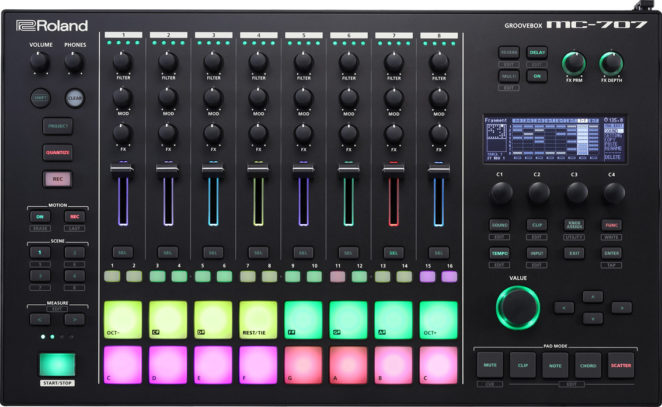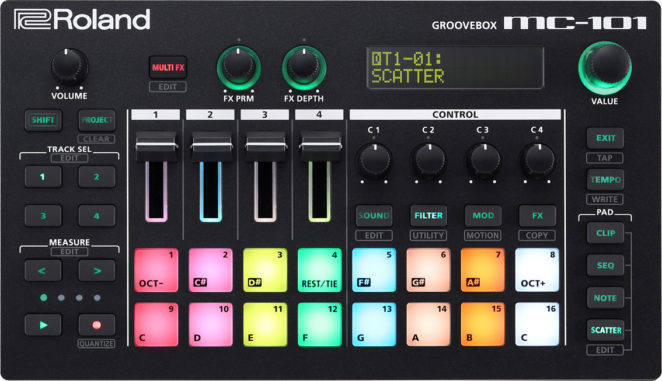
Review by Baz Bardoe
I recently ventured out to Store DJ on Victoria street in Richmond (Victoria) to review Roland’s two new ‘Grooveboxes’ the MC707 and its smaller companion the MC101. Roland really pioneered the idea of an all in one hardware based sequencer and synthesiser when it released the MC303 in 1996. It referenced classic Roland kit which had become synonymous with the dance music scene and allowed the production of credible dance music all with the one compact box. Then came the MC505 which was a huge improvement in terms of its sound quality and sequencing power. And then there was the MC909 which integrated sampling. This was a big step. Samples could be used by the sequencer alongside the synthesiser ad percussion sounds and it opened up a new world of possibilities for music producers who wanted to stick with hardware. However at the time of its release in 2002 there was an increasingly strong train of thought that software would replace hardware altogether. Live electronic music events were increasingly dominated by people behind laptops. As it happens we still see this but there has been a huge swing back towards hardware playing a major role in music production and live performance. Perhaps it relates to Brian Eno’s ideas about the importance of ergonomics in music making, even if it is electronic, but whatever the reason it seems apt that Roland has returned to the fray. And what a return it is!
First let’s start with the MC707. It is vastly more compact than the MC909 so it really occupies a space about the same as a laptop. Roland have done a great job of making the interface very user friendly. There are eight channels and each is separated out into a fader and other controls so there is much less fiddling about with hidden menus than you might expect. In each channel you have the choice of three different sound types – a rhythm sound, a synth or a sample. Each of these is a ‘clip’ and you can have multiple clips stored in each channel location, so with some good planning it is almost limitless in terms of how many different parts you can have in just one channel. The MC707 comes with a big range beats, sounds and phrases but there is huge scope to customise and create your own. Getting going with a rhythm part is very easy via either step time or real time sequencing and there’s the option for quantize in many different variations as well. Likewise choosing a synth sound and getting a part going is very easy. The pads on this feel good to play and invite a bit of jamming. I didn’t get to use the sampler but the feedback I get is that it is simple and easy to use and there are all sorts of features to mangle your samples such as reversing and truncating – staples of today’s electronic music really. In short getting a tune going is very straight forward. This device also stores knob movements as you record each part which is a great feature when you have perfected the perfect filter sweep.
Each channel has a wide range of the sorts of effects you would expect such as chorus, delay, overdrive and so forth. The quality is exceptional. Which brings me to the actual sounds themselves. As we have come to expect from Roland they are brilliant. Biting leads, huge kick drums, warm room filling pads……they are all there and all of them sound great. You will want to play this at box at volume. The controls are very user friendly and invite live performance. Although I didn’t have a huge amount of time with it, I am very impressed. Roland have released a MC909 for 2020 it would seem.

Which brings me to its much smaller friend the MC101. If there was a criticism of the MC707 it might be how small the visual display is, but the MC101 is a bit simpler to look at with its larger and simpler digital display. They key thing is portability and the MC101 can operate from battery power and is quite small. A drawback is that compromises have to be made and the most obvious is that it only has four channels. However just like its bigger sibling each channel can have multiple clips so I imagine that with good planning you could make quite complex music. The sound quality seems to be every bit as good and it will have great appeal to those who prize their mobility. I would expect it to have started making an appearance at live shows as well. A great little box but more of a sketch pad for most users I suspect.
A couple of decades ago most people thought hardware would soon pass into history but it turns out that just as Brian Eno suggested there are ergonomic factors in making music and electronic varieties are no exception. Roland have created something as portable as a laptop that is a very serious production tool with huge scope for live jamming.


